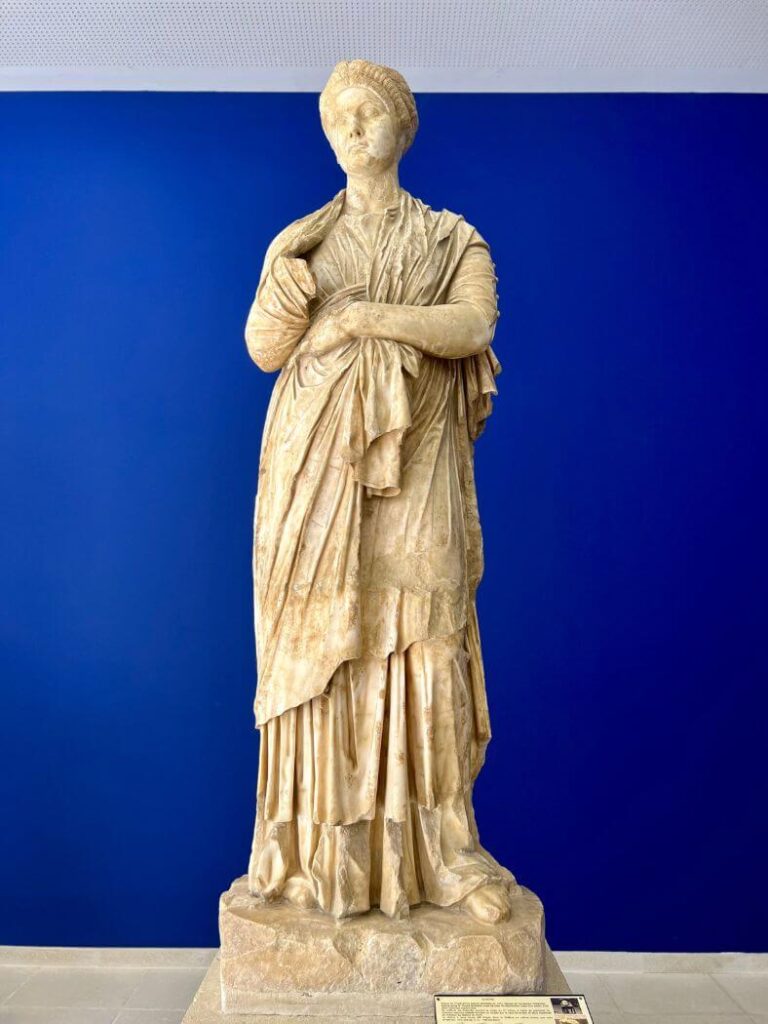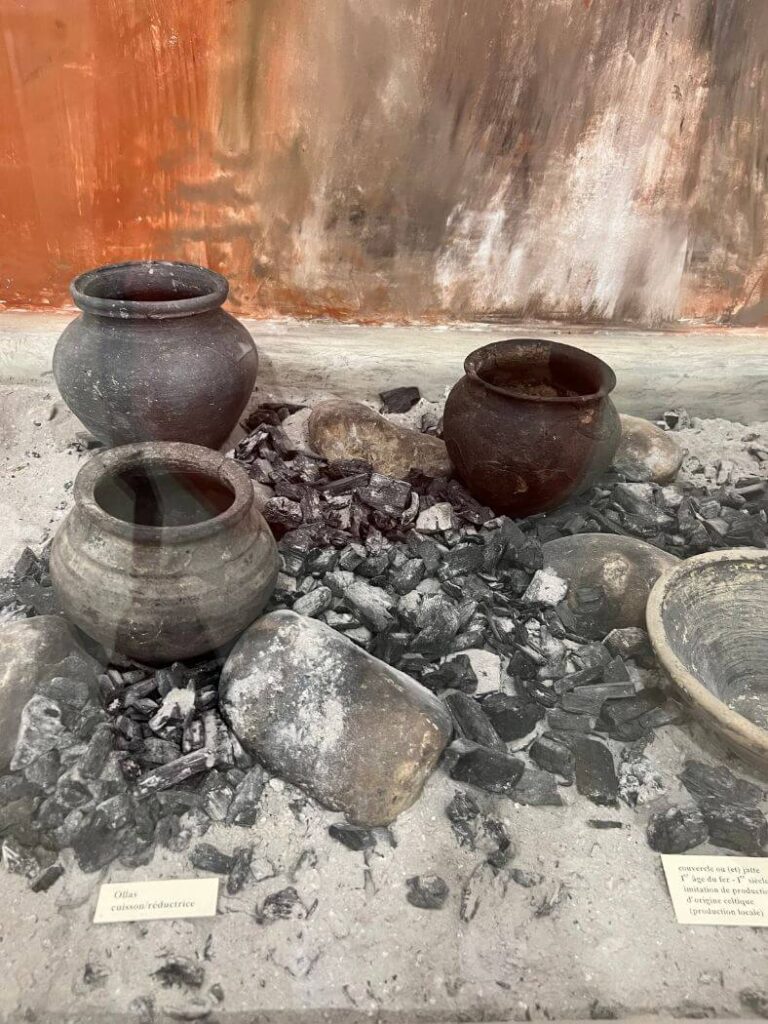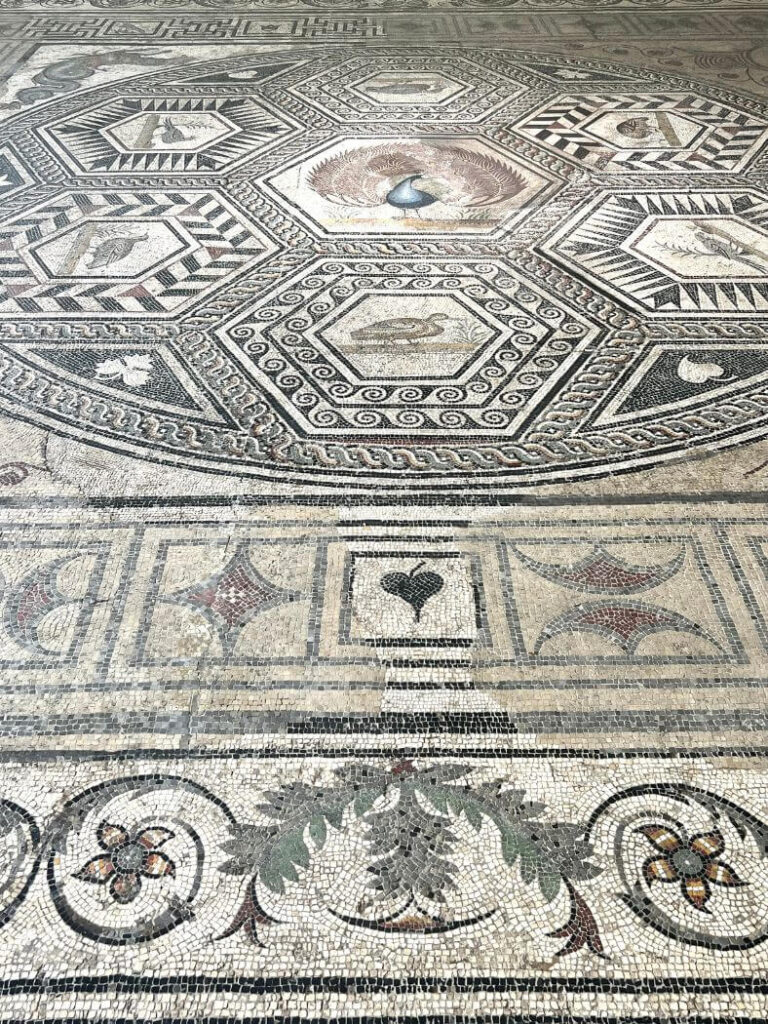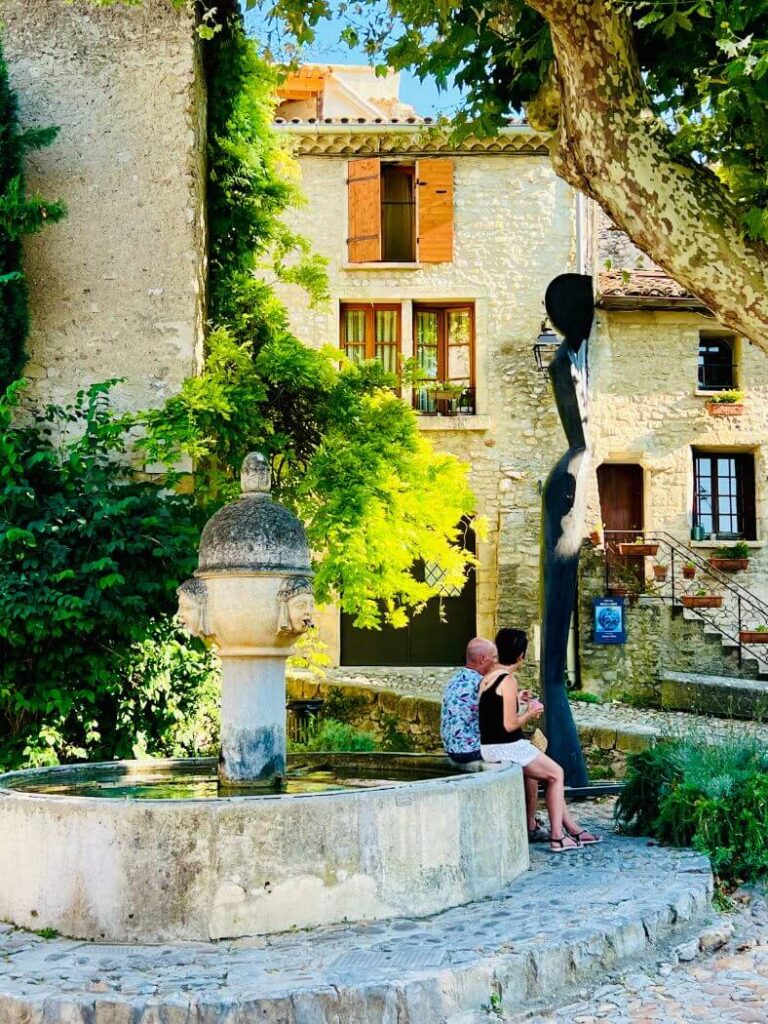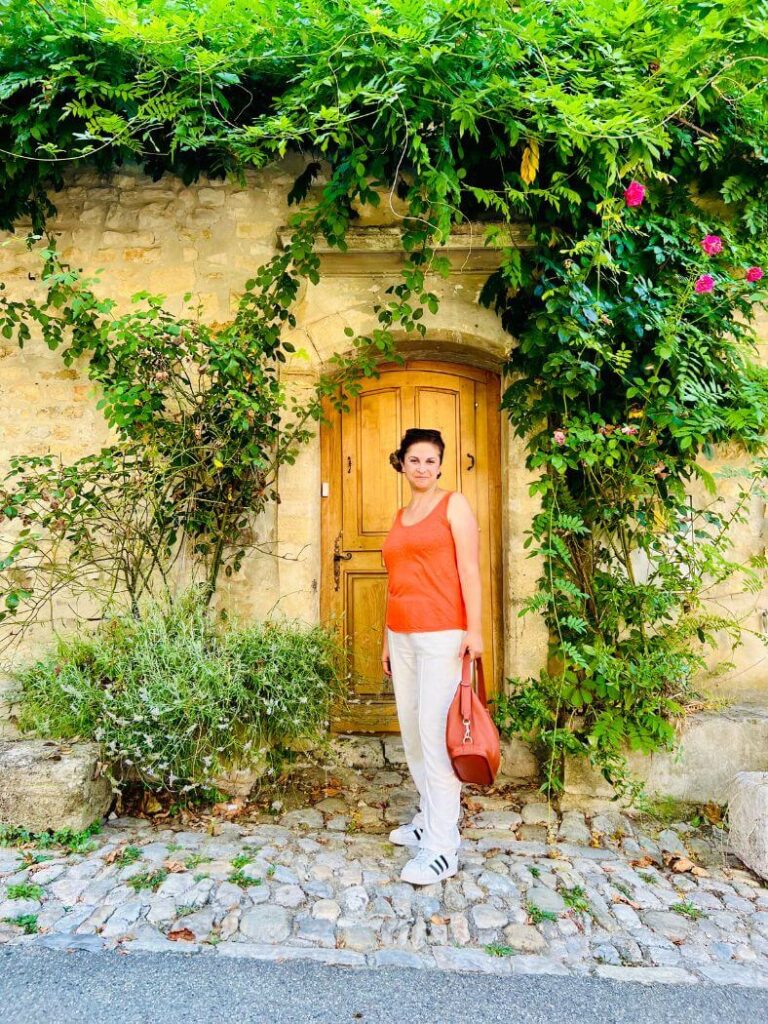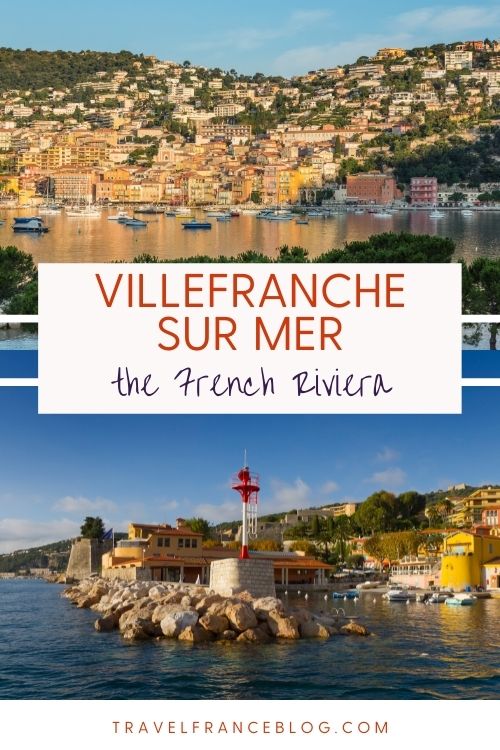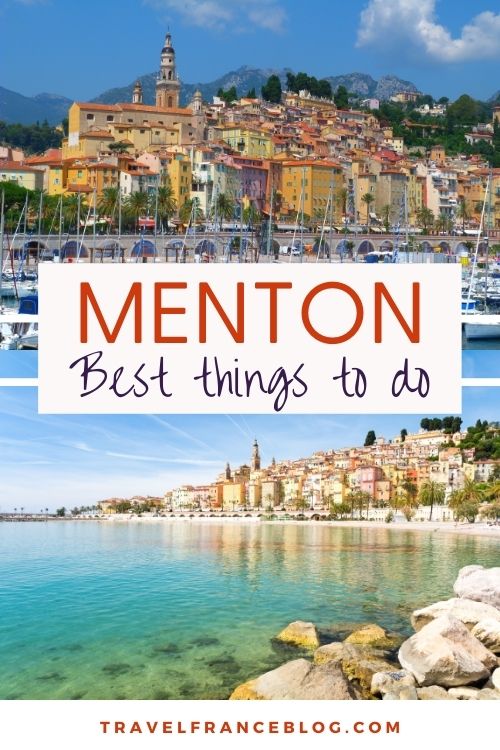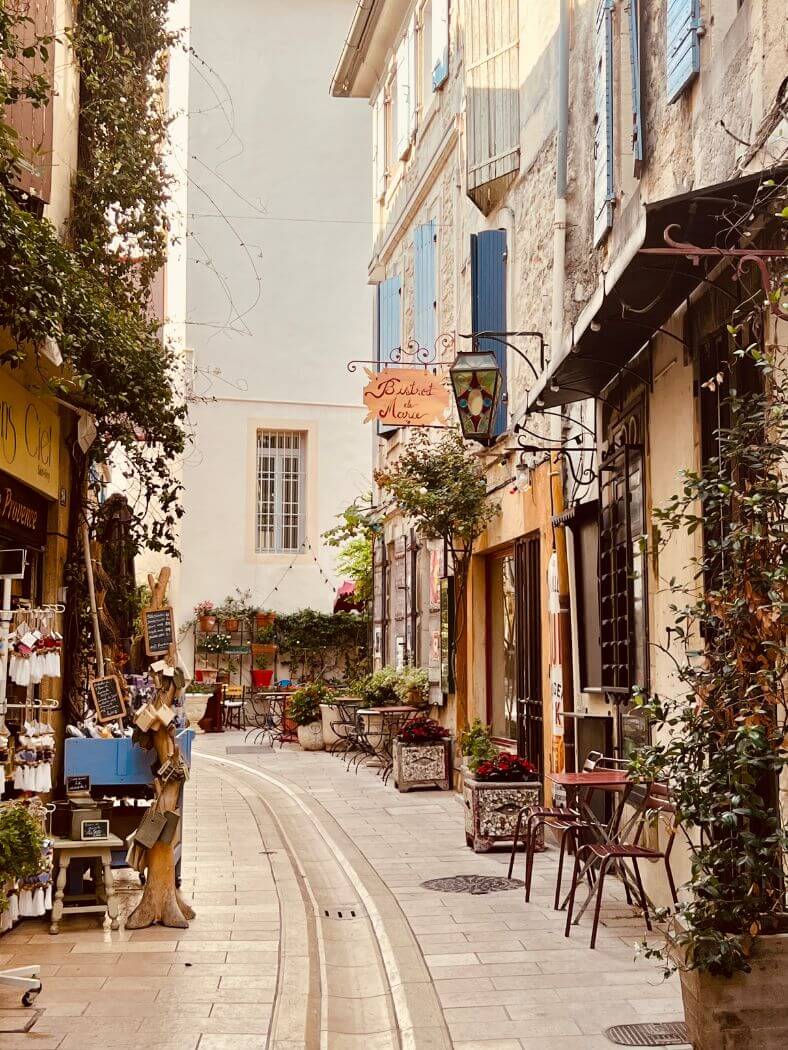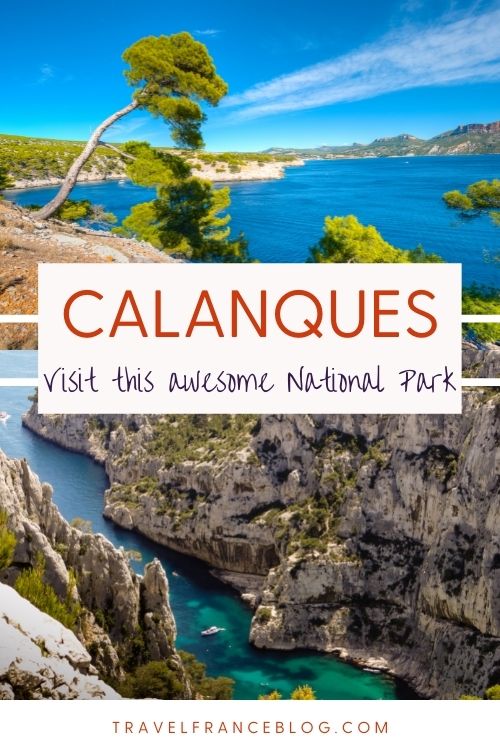11 Best Things To Do in Vaison la Romaine, Provence
Vaison-la-Romaine is a charming town that invites you to step back in time and immerse yourself in its rich history and alluring beauty.
With its well-preserved Roman ruins, cobblestone streets, and delightful local culture, Vaison-la-Romaine is a true gem waiting to be discovered.
Join us on a delightful journey as we uncover this enchanting destination’s hidden treasures and unforgettable experiences.
Do you know? Vaison-la-Romaine is at the Regional Finale of the Favorite Monument of the French in 2023.
So, grab your travel hat, and let’s embark on a friendly adventure through the wonders of Vaison-la-Romaine!
1. Archaeological Sites of Vaison-la-Romaine
Vasio Julia Vocontiurum, situated at the base of Mont Ventoux, was once a thriving city within the Roman Empire and counted among the wealthiest ancient cities in Provence.
Nestled within a lush, verdant landscape spanning over 8 hectares, two well-preserved Gallo-Roman districts (Puymin and La Villasse) unveil the remnants of opulent residences, artisanal quarters, bustling shopping streets, and public baths.
Visit the Archaeological Site of Vaison-la-Romaine! Step into a world where ancient history comes alive right before your eyes. This unique site, located in the heart of Provenza, France, offers a glimpse into the Roman past like no other.
Don’t worry if history wasn’t your favorite subject in school – the Archaeological Site of Vaison-la-Romaine is an adventure that appeals to everyone.
The tickets purchased at the entrance to the Puymin site also grant access to the La Villasse site. To enhance the touring experience, audio guides in French, English, German, and Dutch are available for visitors.
You can use the ticket for 24 hours. The price is 9 per adult.
Le Site Antique de Puymin
At the Puymin site, a leisurely stroll takes you through the heart of an enchanting quarter of the ancient town. Here, you’ll witness the remnants of splendid patrician residences, including the 2000 m² House of the Wreathed Apollo and the 3000 m² “Maison à la Tonnelle.”
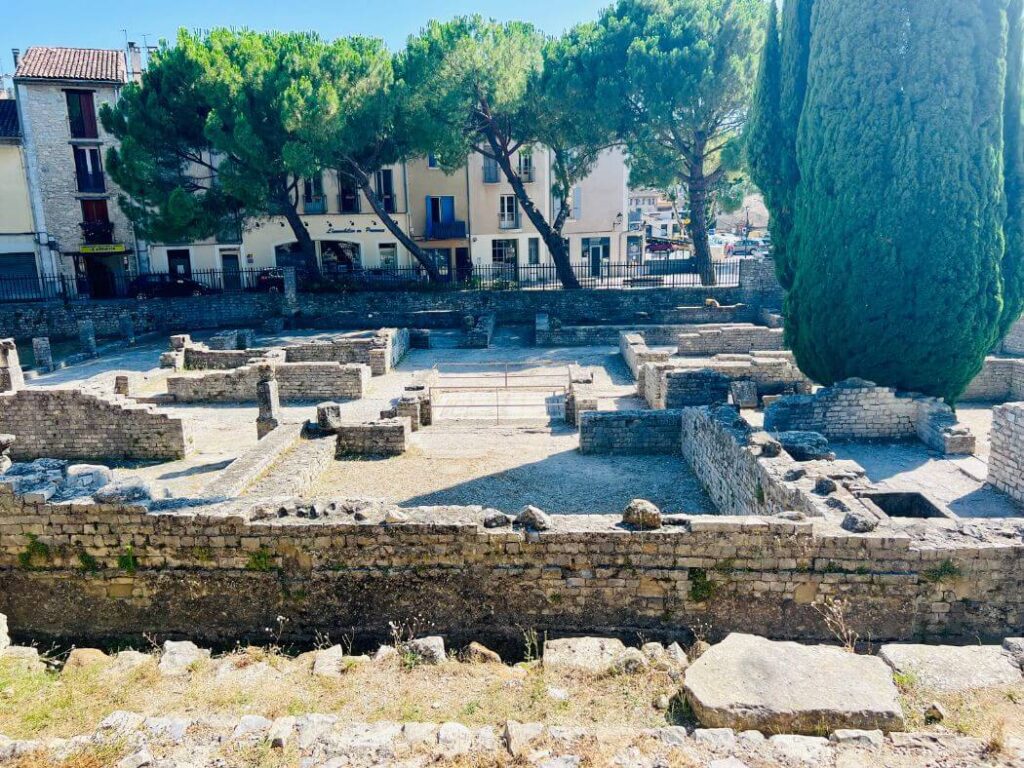
The sanctuary, framed by porticos and featuring a garden and central building, likely served as a space for leisurely walks or worship.
Unearthed by Abbot Sautel in 1912, after centuries of obscurity, the Roman theatre housed statues, now displayed in the Théo Desplans Museum, found in pits concealing the machinery.
The Archeological Museum of Vaison la Romaine
At the heart of the Puymin site, the Théo Desplans Archaeological Museum awaits you.
After extensive conservation work and inventorying, the museum boasts a vast collection of over 2000, including an exceptional representation of Hadrian and Sabina, mosaics, sculptures, altars, and everyday objects.
You can imagine the richness of this Ancient town and the way of life of its inhabitants.
It offers insight into ancient ways of life, ranging from prehistoric times to the Gallo-Roman era, and it is fully accessible to people with reduced mobility.
While exploring the site, you will come across an alignment of sepulchers. In the 5th century, as part of a policy to distance from pagan practices, the theatre’s foundations were repurposed as sarcophagi.
The Theater of Vaison la Romaine
Several paths lead to the remarkable Roman theatre dating back to the 1st century BC. Its stage wall is 25 meters high and has 32 seats arranged in a semicircle.
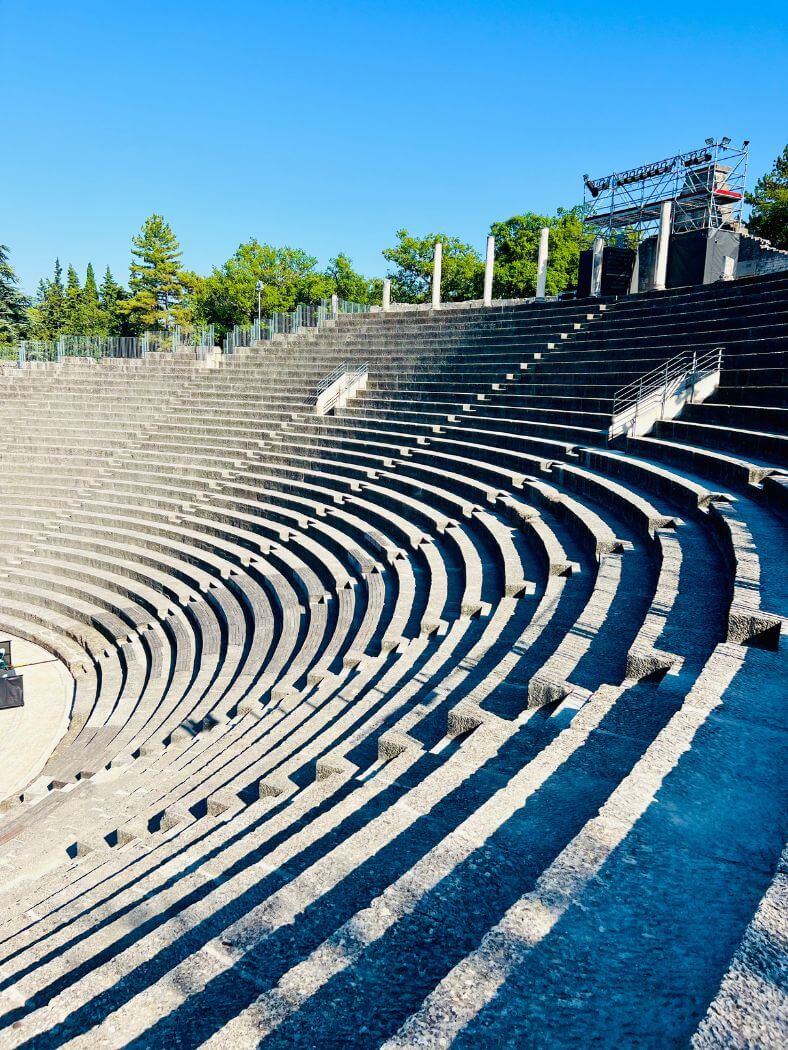
The Vaison la Romaine theater could accommodate 6,000 spectators for comedies, mime, and pantomime shows. Following significant renovations, it continues to host various events to this day, including the Vaison Danses Festival, concerts, and more.
To access the program and book your tickets, you can visit the tourist office.
La Villasse Site
As you cross the parking lot, the archaeological site stretches out below. The street of shops, lined with columns, has preserved its pavement. The Roman forum has been excavated further south beneath the current city.
On the street, a large space opens up, long interpreted as a house known as the “House of the Silver Bust” due to the discovery in 1924 of a superb silver bust, likely representing a notable person, currently on display in the museum.
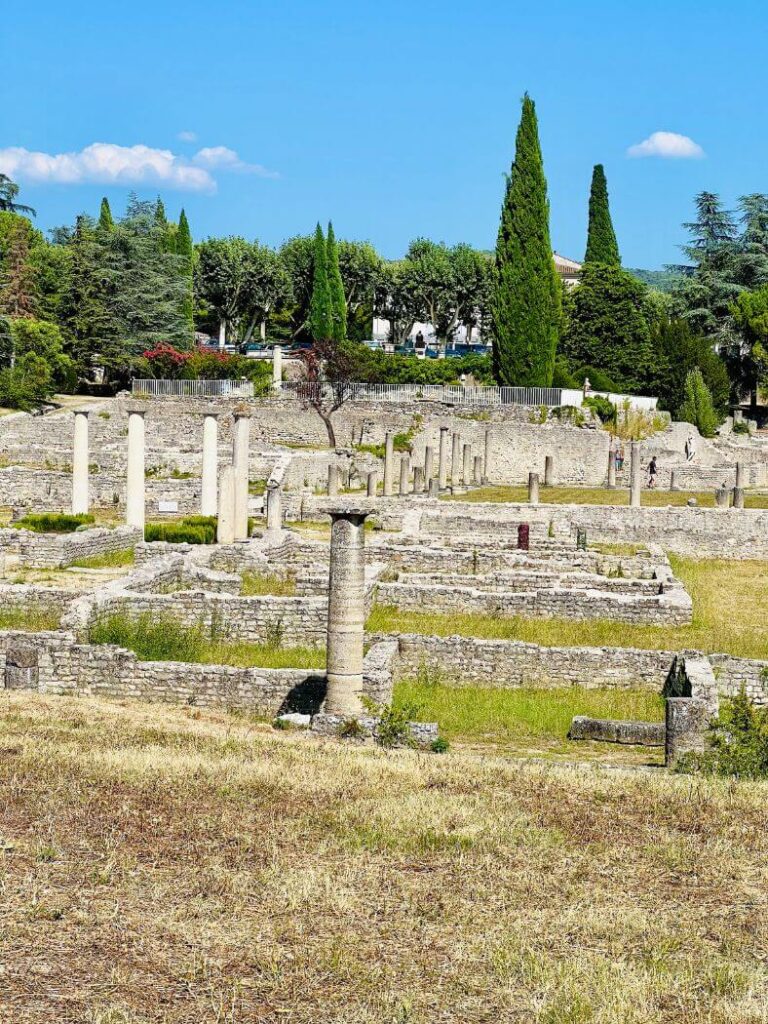
This vast complex of rooms organized around courtyards and gardens would have been a gathering place for individuals of the same profession, possibly serving as a seat for professional associations.
Further on, the “House of the Dolphin” revealed the successive transformations of a modest and rustic dwelling into a comfortable townhouse, bearing witness to the city’s evolution.
Gradually transitioning from a semi-rural world in the 1st century BC to a fully-fledged Gallo-Roman city a century later.
2. Montfort Square
It is the heart of the contemporary city, surrounded by shops and cafes. The remnants of the Gallo-Roman city also extend beneath Place Montfort, as evidenced by the excavations carried out in 2010 before the recent renovations.
3. La Grand’ Rue
The Grand’ Rue of Vaison La Romaine is a semi-pedestrian or pedestrian street, depending on the season, bustling with numerous shops throughout the year. It leads you to the Roman Bridge.
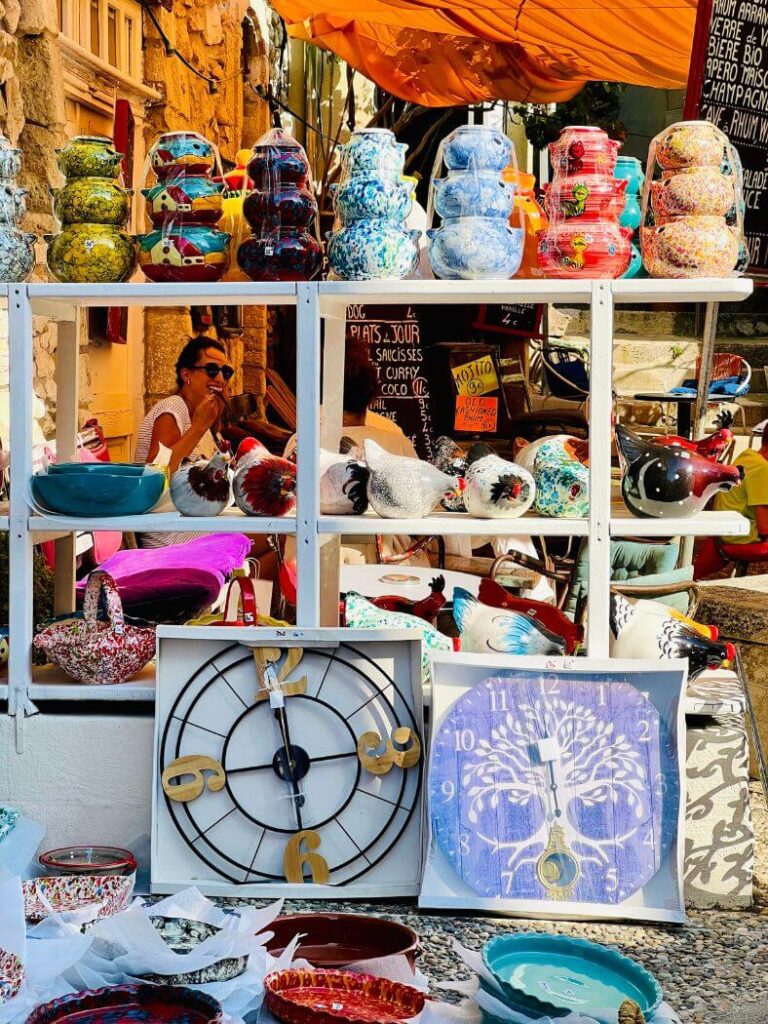
4. Roman Bridge
Anchored in the rock, the Roman Bridge has always been a link between the city center and the medieval citadel on the heights, despite the floods of the Ouvèze River.
During the time of the Count of Toulouse, it held a strategic role as an obligatory passage and served as a toll station. In the 15th century, it also served as a surveillance post.
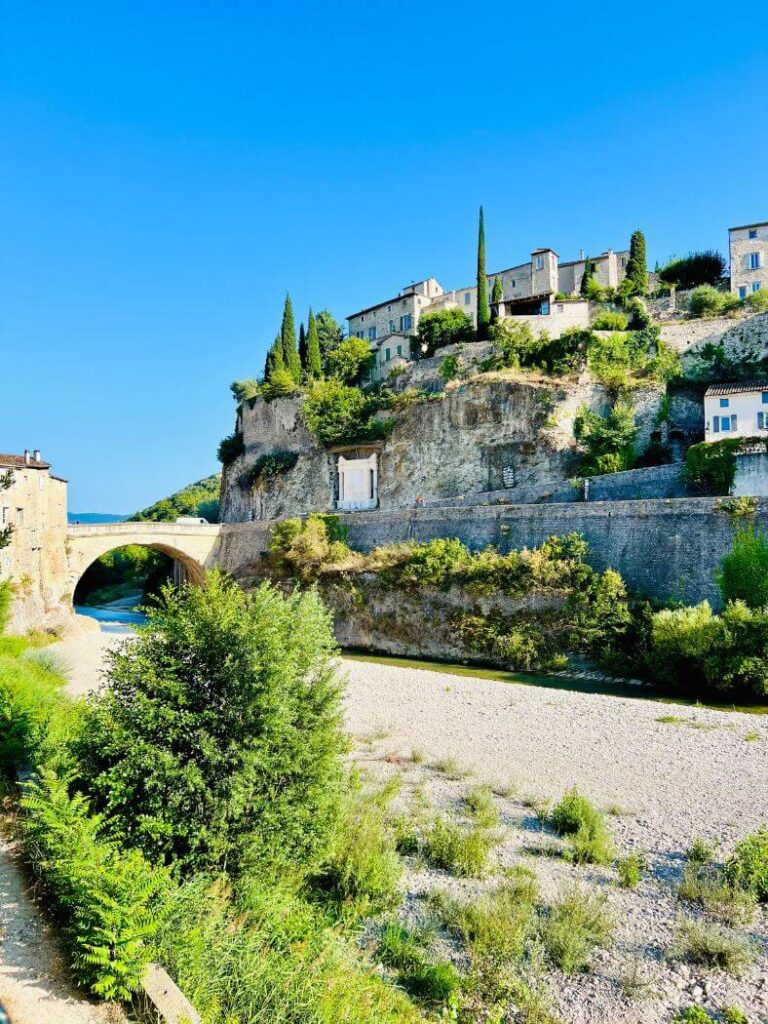
The bridge has a single arch measuring 17 meters long and 9 meters wide, making it the widest of all Roman bridges in Gaul. Its construction dates back to the end of the 1st century AD.
Designated as a historical monument in 1840, it stands among the few ancient bridges still in use today.
5. La Haute-Ville (The Upper Town)
Once you cross the Roman Bridge, get ready for a little adventure! Follow along the city walls and then spot the charming Belfry with its campanile on top.
This will lead you to the high town, a lovely and fortified habitat surrounded by a double enclosure, and the magnificent Comtal Castle towering above.
To enter this magical place, you have two gateways: the Old Gate, also known as the Saint Quenin Gate, just below the Belfry, and the New Gate to the east. They’re like the secret doors to a fascinating world!
As you explore, don’t forget to wear comfy shoes because there’s a lot to see! From the Place du Vieux Marché, the heart of the high town where the market used to buzz until the 19th century, take a moment to admire the walls adorned with fern-like facades that once protected the Jewish quarter.
And the view from the Planet, right in front of the church, oh my! You’ll be treated to a breathtaking panorama of the Ouvèze River and the majestic Mont Ventoux. Go on a bike tour to enjoy your time at your own pace.
But the real charm lies in wandering through the narrow and picturesque streets. They have such evocative names like “Rue des Fours” (Oven Street) and “Rue de l’Évêché” (Bishop Street).
It’s like stepping back in time as you pass by old private mansions and charming little squares with adorable Comtadine fountains.
So, grab your good shoes and get ready for an enchanting journey through history!
6. Notre-Dame-de-Nazareth Cathedral
The Notre Dame de Nazareth Cathedral is a true masterpiece that should not be missed during your visit to Vaison-la-Romaine. This majestic Romanesque church, dating back to the 11th century, is a testament to the town’s rich history and architectural splendor.
This cathedral is the most eloquent monument of the medieval and Christian city. In the 11th century, it was constructed on the site of early Christian buildings and later transformed in the following century.
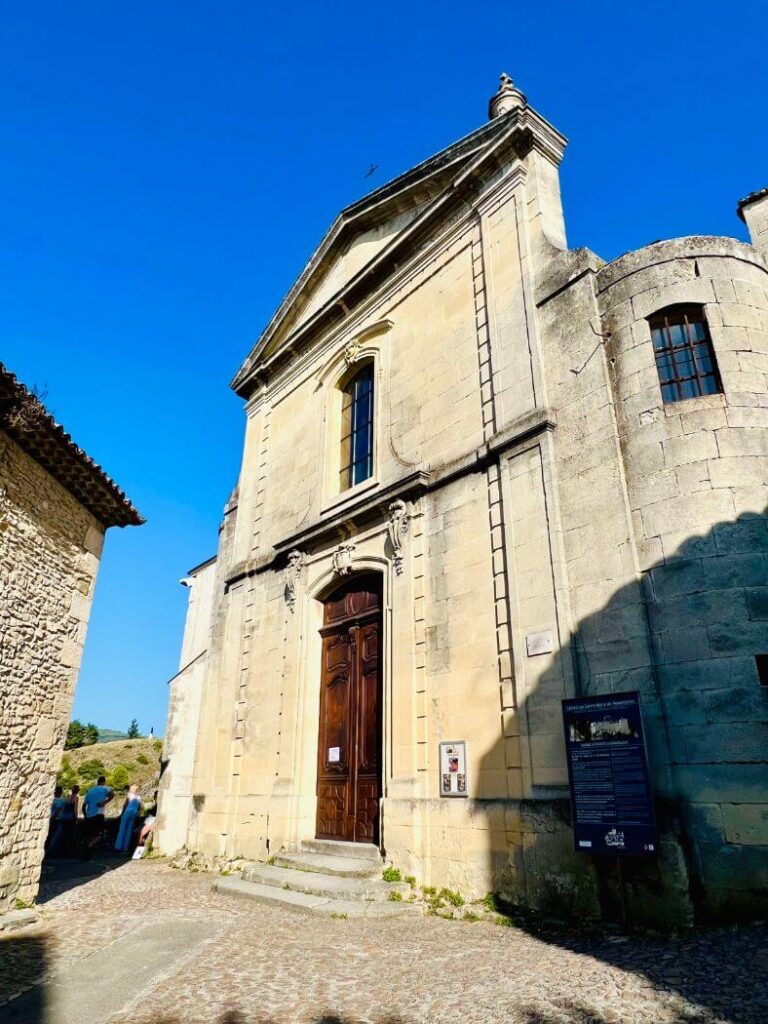
One of its fascinating features is the presence of reused ancient remains in its construction, like the Roman architectural blocks found in the foundations of the apse.
Its simplicity and massive appearance, with few openings, its vaults, arches, and sculpted decorations inspired by antiquity, all reveal it as a wonderful example of Provençal Romanesque art.
From the 12th-century reconstruction, we admire the beautiful octagonal dome on pendentives, adorned with the symbols of the four evangelists: the angel of Matthew, the ox of Luke, the eagle of John, and the lion of Mark, as well as the vaults of the nave and the side aisles.
This cathedral is a true treasure that brings the history and art of the region to life. Don’t miss the chance to explore its remarkable features and immerse yourself in the beauty of Provençal Romanesque architecture!
7. Castle of the Counts of Toulouse
The upper town is nestled at the foot of the castle, built in 1195 by Raymond VI, Count of Toulouse. He wanted to assert his authority against the bishop who had established himself as a lord in the medieval town (valley).
You enter the town through a fortified gate from the 14th century, dominated by the Belfry Tower. Back then, the guard room under the tower operated the drawbridge, the grand gateway, and the portcullis that protected the entrance – you can still imagine it today.
The citadel, protected behind its walls, was spread over approximately 3 hectares in an irregular pattern of alleys and buildings largely constructed with reused materials from ancient and medieval structures in the valley.
Main streets were cleverly sloped to facilitate traffic and the establishment of noble and bourgeois homes.
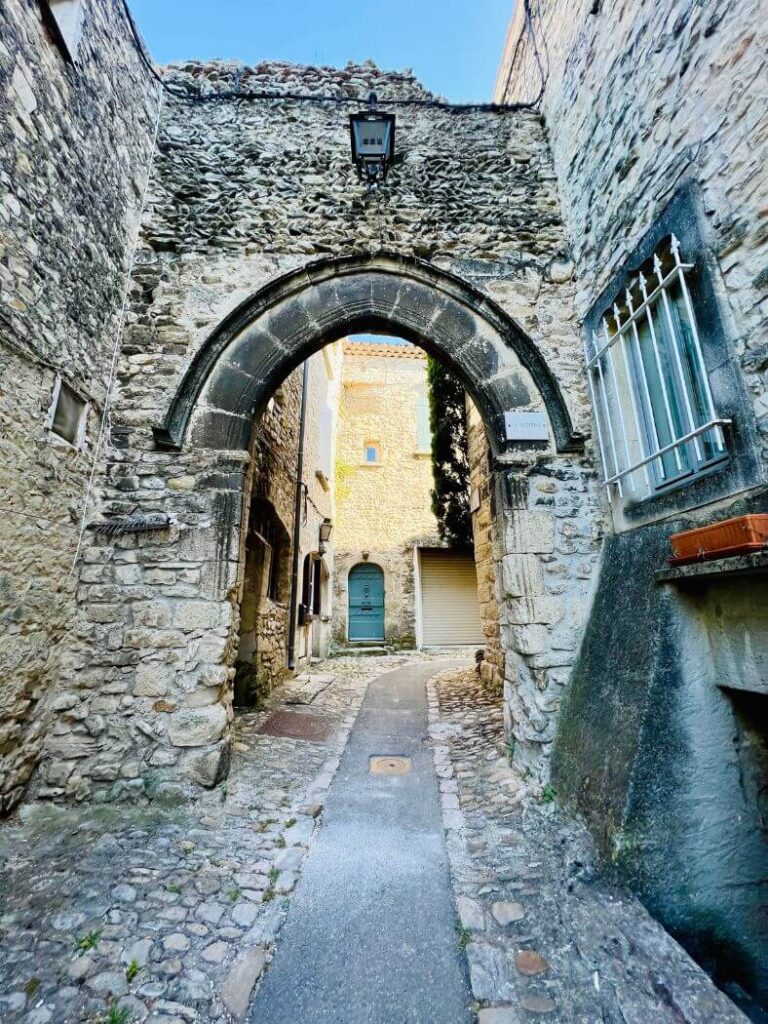
These streets, connecting the Old Market Square to the west and the Church Square to the east, are adorned with beautiful calades (named after the stones carefully placed side by side to form the surface) and bordered by some impressive private mansions.
Notable on Rue de l’Evêché is the Fabre de Saint-Véran mansion, home to the Beffroi Hostelry, boasting perfectly preserved 16th-century door frames.
Further on, the Brotherhood of White Penitents chapel adjoins the townhouse of the Taulignan family and those of the de Montforts. As you continue, you’ll pass by the former bishop’s palace, dating back to the late 16th century.
At Orme Square, you’ll see the Prevostry House of the Chapter and the facade of Sainte-Constance Chapel. Finally, facing the church at the eastern end of the rocky hill stands the meticulously maintained de Blégiers residence.
The cathedral church, initially started in the second half of the 15th century, has undergone numerous transformations for expansion and beautification, reflecting different architectural styles.
While waiting for its restoration, the building remains closed to the public. Still, the visitors will be captivated by the façade in Jesuit style, the unusual roof of the bell tower, and its reused medieval decorations.
A few steps away, the square overlooks the Ouvèze Valley, offering a splendid panorama. From here, you can admire the Roman bridge area and the river while taking in the breathtaking perspective of Mont-Ventoux.
8. La Chapelle Saint-Quenin
One of the most beautiful examples of Provençal Romanesque art, inspired by ancient architectural models, is this cathedral, which features a curious triangular apse.
Dedicated to the city’s patron saint, it was built in the second half of the 12th century on a site once a necropolis during Roman times.
Take a moment to admire the intricacy of the decorations on the columns and pilasters, adorned with magnificent acanthus leaf capitals supporting an impressive ancient-style entablature with a frieze under the cornice.
Note: The church is closed to visitors and cannot be toured except during special events.
9. Le Jardin des 9 Damoiselles
This poetic garden comprises 81 granite blocks engraved with symbols and texts in the languages of 9 European cities of cultures. It was created after the floods of 1992.
A bamboo grove borders this contemporary layout and extends into the Nature Space of Théos, which offers a fitness trail, an orienteering course, a children’s playground with a water feature and picnic area, and a city stadium (a multi-sports playground, roller skating track, and ample spaces for walking, running, or simply relaxing).
10. Provençal Market on Tuesday
Enjoy a leisurely stroll through the vibrant Provençal market on Tuesday mornings, filled with the delightful colors and scents of the Provence. With up to 450 exhibitors during the summer, this bustling market sprawls throughout the entire center of Vaison-la-Romaine.
Indulge in various treats as you browse through stalls offering fresh fruits and vegetables, local produce, artisanal goods, clothing, vintage finds, kitchenware, and charming gifts.
Held every Tuesday morning from 7:30 am, the market transforms the main squares and streets of the town into a warm and inviting Provençal ambiance.
Dating back to 1483, this market has a rich heritage, authorized by a papal bull from Pope Sixtus IV, allowing Vaison to host a market.
In 1532, Pope Clement VII confirmed this tradition and designated Tuesday as the market day. Back then, it took place in the upper town on the square known as “Place du vieux marché.”
Today, it has become one of the region’s largest and most colorful markets. Moreover, on François Cevert Square, you’ll find an exclusive market reserved for local small producers, offering a wonderful selection of regional delights.
If you can’t get to Maison la Romaine on Tuesday, try to go on Saturday between 8 and 1 pm. It’s all year market.
11. Local Gastronomy in Vaison la Romaine
Indulge your taste buds in the delightful flavors of the local gastronomy in Vaison-la-Romaine! Provençal cuisine is a feast for the senses, offering a delectable blend of fresh ingredients, fragrant herbs, and Mediterranean influences.
Treat yourself to the savory delights of ratatouille, a hearty vegetable stew bursting with flavors. Don’t miss the opportunity to savor the famous soupe au pistou, a comforting vegetable soup topped with a delicious basil and garlic pesto.
Sample the rich olive oils, exquisite cheeses, and mouthwatering tapenades, each reflecting the essence of the region’s culinary heritage.
And, of course, a meal in Vaison-la-Romaine wouldn’t be complete without a glass of local wine cultivated in the nearby vineyards that add to the charm of this gastronomic journey. Bon appétit!
Curious and Historical Facts about Vaison la Romaine
Vaison-la-Romaine was founded in the 2nd century BC by the Romans and became an important city in the ancient province of Narbonensis Gaul.
The Voconces had Vasio (Vaison) as their capital and were already producing a sweet wine praised by Pliny the Elder…
The Roman Theater of Vaison is one of the best-preserved in France and has a capacity for more than 6,000 spectators.
The city is known for its “Ponte del Diablo” (Devil’s Bridge), a medieval bridge that crossed the Ouvèze River. Throughout its history, the bridge has been damaged and rebuilt several times.
During the summer, Vaison-la-Romaine hosts a famous dance and music festival called “Vaison Danses,” which attracts artists and spectators from all over the world.
Travel Tips to Vaison la Romaine
1. Best time to visit: Spring and fall are the best times to visit Vaison-la-Romaine when the weather is pleasant and there are fewer tourists. Summer could be pretty hot. If you visit it during summer, the best time to walk around is in the morning. From 12 pm to 6 pm, it’s too hot.
2. Comfortable footwear: The old town has cobblestone streets and slopes, so wearing comfortable shoes for walking is highly recommended.
3. Accommodation: For a more authentic experience, consider staying in a guesthouse or boutique hotel in the historic center.
4. Bike rental: If you enjoy cycling, consider renting a bike to explore the surroundings of Vaison-la-Romaine, which has scenic routes.
5. Book in advance: If you plan to visit the Roman theater or participate in special events, it is advisable to book in advance.
6. Try local cuisine at local restaurants and markets.
How to Get To Vaison la Romaine
had the most delightful journey there, and I can’t wait for you to experience it too. So, here are your options:
- By Car: Driving to Vaison la Romaine is an excellent choice! The scenic roads take you through picturesque landscapes, and you have the freedom to explore the surrounding areas at your own pace. You can rent a car in advance here.
- By Train: Although the town doesn’t have its own station, taking a train to nearby Avignon TGV or Orange station is convenient. From there, it’s a short ride to Vaison la Romaine – easy peasy!
- By Bus: If you prefer a relaxing ride, the regional buses are a good option. They’ll take you directly to the town, and you can sit back and enjoy the views.
How to Move Around Vaison la Romaine
Believe me, the best way to move around Vaison la Romaine is on foot! The old quarter is so charming, with its cobblestone streets and ancient architecture. Walking through the historical alleys and exploring each tourist spot made me feel like a time traveler.
But hey, if you’re feeling adventurous and want to see more of the countryside, rent a bicycle! Cycling through the vineyards and quaint villages is a true delight – it’s like pedaling through a postcard! You can rent them online and use Wise as your payment method.
Where to Stay in Vaison la Romaine
Hôtel Burrhus is a win-win for travelers like me! Cozy rooms and everything I wanted to see within walking distance – couldn’t ask for more.
For mid-range options, Hôtel la Fête en Provence is a hidden paradise. After exploring, its pool and garden were perfect for unwinding. Hostellerie Le Beffroi‘s historic charm, exquisite restaurant, and top-notch facilities?
Exceptional and oh-so-pampering. Travel back in time and fall in love with Vaison la Romaine’s enchanting mix of history and beauty. A destination that leaves a lasting impression on your soul.
Plan Your Trip to Vaucluse
- Best Things to Do in Roussillon
- Best Things To Do in Avignon
- A Travel Guide to Gordes
- Major Cities of Provence
- Most Beautiful Villages in Provence
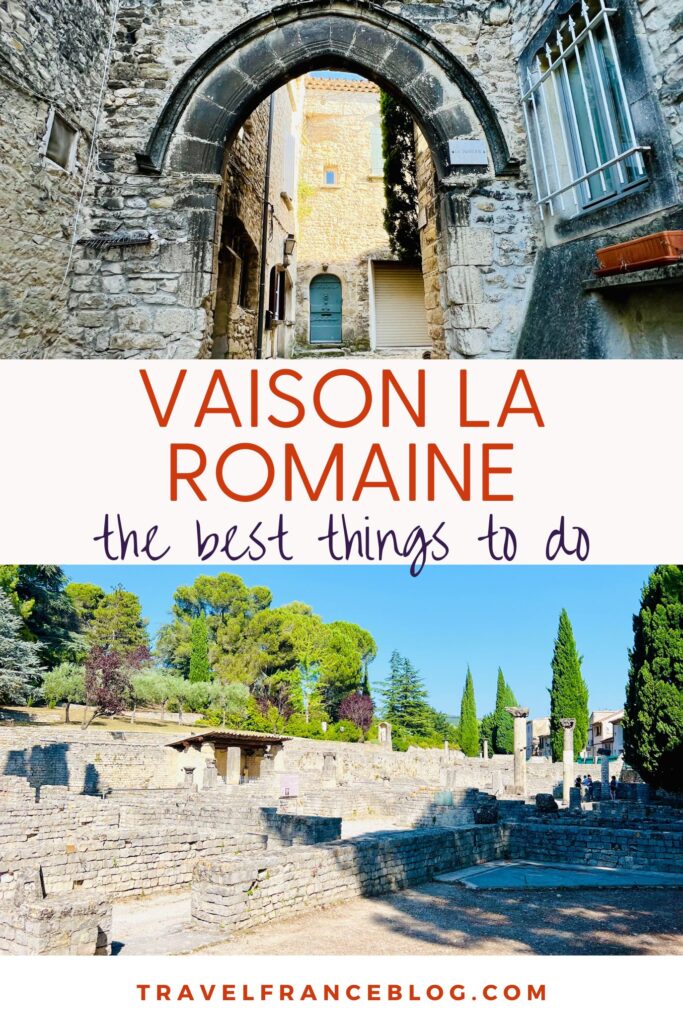
This post may include affiliate links. This means that we will receive a small fee if you make a purchase through our links. It has no additional cost to you. It’s a win-win!
